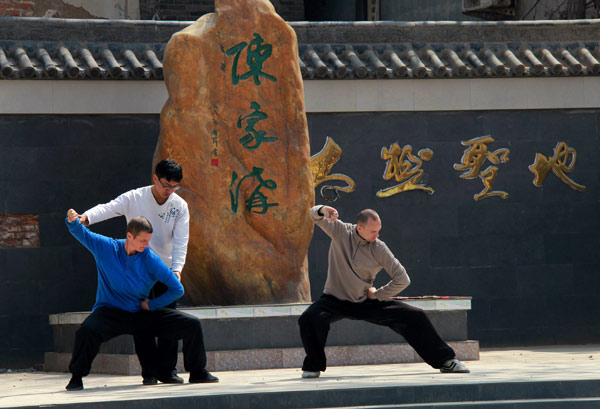
Tai chi teacher Chen Zhiwei instructs two foreign visitors at a private wushu school in Wenxian county, the origins of the ancient martial art in Central China's Henan province, April 8, 2013. Thousands of foreigners visit the county every year to learn tai chi. It is reported that more than 200 million people practice tai chi across the world. [Photo/Asianewsphoto]
I recently made a trip to China. Though I only had time to visit three places – Hong Kong, Macao and Beijing – the country made a deep impression on me.
For one, it was nothing like I expected. I had arrived with a backpack and a good camera, hoping to capture some snapshots of traditional life in Chinese streets. But at the same time I suspected that the old ways had disappeared to make way for grand buildings and other symbols of newfound wealth. I couldn’t have been more wrong.
For sure, the glitz and ritz are there, but by no means has it replaced street life. Everywhere I turned, I saw people taking advantage of public places to play strange (for me) musical instruments, practice tai chi and dance. Cars crowd the roads, but that doesn’t mean locals have abandoned their bicycles. Seeing cyclists expertly weave their way through the traffic, sometimes balancing an infant on their lap, was both a delight and an affirmation that traditional China lives on.
My first port of call was Macao, long a Portuguese colony before it was returned to China in 1999. I traveled there from nearby Hong Kong.
My first impression of the coastal cities actually smacked me in the face as I stepped out of Hong Kong airport – the air. It’s heavy, hot and humid. In summer, you can almost see it. Though Macao and Hong Kong are located only just south of the Tropic of Cancer, they boast a humid subtropical climate.
I boarded a ferry to Macao from the Hong Kong ferry terminal. The two special administrative regions are 60 kilometers apart, but the ferry covered the distance in no time at all. Looking out of the window, we felt like we were flying. We almost were – the ferry was a hydrofoil, its hull rising far out of the water at full speed.
I disembarked amid jostling crowds. Most were businessmen who headed to Macao from Hong Kong to try their luck in the casinos. They hit the tables in the evening, spent the night in a hotel – hopefully paid for by winnings – before heading back to their lives in Hong Kong in the early morning.
I avoided the casinos. The streets were what I wanted to see. I started out from the old town, at the center of which is Senado Square. It’s surrounded by picturesque colonial buildings and is paved in classic Portuguese style. The stones of the pavement emanate out from the square in black and white waves.
I had grown used to the humidity by now, and shifted my attention from breathing to the surroundings. No doubt, it was a strange feeling standing on Senado Square – architecturally, the area looked like a small old Mediterranean village. But I was in Asia! The unintelligible chatter of the local Chinese dialect filled my ears and I felt disorientated.
This blend of the Far East and the classic West is everywhere in Macao. I found it, for instance, near the baroque ruins of St. Paul Cathedral and along the Fortaleza do Monte fortress. These sites are classic “Old Europe,” but are surrounded on all sides by rows of Chinese food stalls and knick-knack shops featuring signs written in traditional Chinese characters.
I also felt the East-West blend in the Camoes Garden, a small Eden in a residential area. Old men gather there to perform in Chinese musical ensembles, while younger ones play a variety of sports more familiar to Westerners, like basketball.
To prove Macao’s Portuguese bona fides many locals will point out danta, or egg tart. But even though the delicacy is billed as the sister-treat of Portugal’s own natas, the Macanese variety is more like a distant cousin. Delicious in its own right, Macao’s egg tart is another instance of East blending with West.
I encountered many things in and around Macao with which I associated the Orient of former days.
In the A-Ma Temple, for instance, on the southwest tip of the Macao Peninsula, I witnessed locals lighting incense sticks to pay homage to the goddess Matzu, who is believed to protect fishermen. Similar rituals were also performed in Taoist and Buddhist temples across Macao, as well as in Taipa and Coloane, two main islands under the special administrative region.
People seemed to live slowly in Macao. Per head, the region is as wealthy as Hong Kong. But it’s less frenetic. As Macao develops its people have managed to retain their unique heritage and customs. It was extremely comforting to wander by the Fortaleza do Monte at the end of a busy day, sit down on a park bench and admire the tai chi practitioners perform the same routine performed by the many generations before them.
